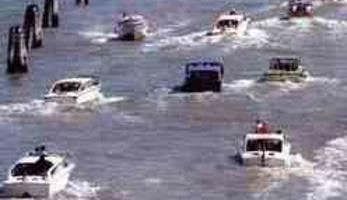Introducing passenger-friendly waterbuses with low environmental impact
Summary
As a result of this measure, waterbuses with reduced impacts on the environment were introduced on a route that was previously inaccessible to disabled passengers.
Implementing sustainable mobility
Throughout Venice’s history, waterborne transportation has been a critical and integral part of the city’s transportation system. The city has one main point of access, Piazzale Roma, the point of entry for visitors from Mestre and the mainland. The waterborne traffic arteries in Venice form an outer ring and an inner ring.
The city now faces many traffic-related problems, including noise, pollution and congestion, as well as the specific problem of damage caused to buildings by wake motion directly due to boat traffic.
The main objective of the measure was to improve public waterborne transport in terms of both environmental impact and access for all passengers. Prior to MOBILIS, the Piazzale Roma/Murano “around the city” route was served directly by “motoscafi”, which are smaller waterbuses with a capacity of 154 people but which lack facilities to enable access by people with disabilities. Passengers with reduced mobility travelling from Piazzale Roma to the hospital and to Murano Island were therefore obliged to take a boat to reach San Marco Square, in the opposite direction, and change for a larger boat (motonave) to reach Murano Island.
Within the MOBILIS project, 18 new waterbuses (motoscafi) with a lower environmental impact were put into service to improve and strengthen strategic waterborne public transport lines that circumnavigate the historic city of Venice. The new waterbuses were accessible to disabled users, allowing them to reach their destination directly.
Progress
The measure was implemented between February 2005 and April 2007.
After the detailed design and approval of the new waterbus, the public transport operator ACTV launched a tendering procedure for the construction and testing of waterbuses. After the new waterbuses were introduced into the ACTV fleet, training was held aimed at both on-board and maintenance personnel to accustom them to the new on-board equipment such as the GPS and the facilities for disabled passengers. The boat crew also need training on the manoeuvrability of the new boats, given their bigger size and the specific characteristics of the routes on which they were to be used.
All 18 new waterbuses were put into operation in 2007, allowing residents and tourists to reach the Lido, Murano Island and the hospital directly.
Outcomes
ACTV greatly increased the fleet capacity for transporting users with reduced mobility. The proportion of motoscafi boats allowing the safe transportation of disabled passengers reached 27.3 percent at the end of 2006 and 32 percent at the end of 2007, making ACTV a passenger-friendly waterborne transport company.
The new boats are wider and offer a larger boarding space for wheelchairs, with a smaller height different between the docks and boarding area. These improvements offer better accessibility for people with disabilities and more comfortable, safer travel conditions. With the introduction of the new waterbuses, disabled passengers save more than two hours in winter and nearly one hour in summer on the journey to Murano Island from the bus terminal in Piazzale Roma.
With additional services put in place by the city of Venice, it is estimated that by 2008, almost 70 percent of the historic city centre was accessible to people with reduced mobility.
The new waterbuses also reduce the risk of environmental damage. Research carried out by the ACTV technical office in collaboration with the University of Trieste led to improvements in the shape of the hull and in the boats’ hydrodynamic performance, with a reduction in motion resistance of about 23 percent (at 20 km standard speed) and consequently lower wave resistance. There was also a considerable reduction in noise: at most points in the passenger area the reduction exceeds 10 db, thus passengers are able clearly to perceive the improvement.
Customer satisfaction with the ACTV navigation services, specifically regarding the environment and facilities for disabled people, was positive overall.







